Setting:Inn0cence: Lost Future/Machine: The Abandoned: Difference between revisions
1d4chan>BeastsOfHysh (Undo revision 685738 by I LOVE gardevoirs! (talk)) |
m (96 revisions imported) |
(No difference)
| |
Latest revision as of 20:01, 24 June 2023

What is Life? Is it rushing blood, muscle and bone and straining tendon? But at the most basic cellular level, molecules snap and twist, clicking like clockwork. The search for an animating vitae, a “life force,” was called off long ago.
What is Mind? Is it sparking axon and firing synapse, flavored by a bath of hormones as it passes that infinitesimal gap? Once the Mind was thought to be a separate entity, commanding the body but of different essence. But consciousness is now know to dwell only in masses of binary tissue; the nerve either fires or it does not, One or Zero.
What is Soul? If the body is a machine and the brain a computer, then what special status can the born and grown claim over the designed and constructed? If life can be reduced to mechanistic principles, then what of the machines themselves?
Perhaps the only trait that sets the organic apart from the synthetic is Purpose. The spawn of DNA, the self-replicating things that slither and swim and crawl and walk and run and fly upon this planet have no purpose apart from survival and continuation. No maker, no design, no destiny. The device's purpose, however petty and short-sighted, is clear; the product of another being's cleverness. And though the device may spin and chirp and resemble a living thing, when its usefulness is at an end, it is cast into the trash-heap without a second thought, and it moves no more.
Because no machine, bereft of Life, of Mind, of Soul, would still strive to function after its purpose was at an end.
No machine would seek to Live.
Summary[edit]

This supplement uses the nWoD Storyteller system, but the content is not linked to the urban horror/fantasy setting. While by necessity it conforms to the laws of narrative causality and game logic, Inn0cence follows the conventions of sci-fi, not fantasy.
But these rules are also a toolkit, not necessarily tied to the verdant post-apocalypse of the Lost Future. The Storyteller system is broad enough to run classic Cyberpunk or Space Opera if the fancy takes you, and this writer isn't going to veto a near-future WoD game of Vampires vs Robots.
Machine characters fall somewhere between vanilla humans and WoD supernaturals in power-level. They are resilient and highly adept in a few specific fields, but dependent on a technological infrastructure. They cannot heal damage to their shells without direct intervention, and some jobs need a 2nd person to do properly. A part can only be repaired so many times before it must be replaced with a spare, and the default assumption is that Machines will have to pick through dumps and ruins to keep themselves running.
The applications are also slightly toned down compared to, say, Vampire disciplines. And as emergent sentients, machines can initially reach only so much expertise in a broad field, however much they specialize in a single subject.
Robots also suffer a hefty social penalty when dealing with many humans. Their own lack of emotional maturity or understanding of human behavior means that they often put their feet in their mouth or fail to read situations correctly. And that's before one factors in the unease, resentment, fear, or outright hatred that humans may harbor themselves.
The Machine Template[edit]
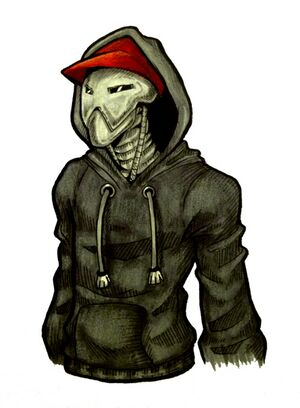
Add +1 dot to a single attribute. This attribute must be favored by your Shell. This dot is added before starting attributes are purchased.
Begin with 3 dots for Applications. At least 2 of these dots must be spent on an Application favored by your shell.
Gain the following traits:
12% titanium: A machine's shell is hardly an inert slab of metal and plastic; tubes and wires fill even the simplest of components, and more complex shells contain tensile cables filled with fluid and other, more intricate tissues. Machines are simply less subject to the various complications of injury, and their outer casing is much more resilient than human epidermis. Machines convert half of all incoming lethal damage into bashing, rounded up. A Machine always counts as wearing 1/1 armor. This armor does not stack with subsequent worn armors. Machines do not heal naturally, and must be manually repaired with the Crafts skill.
Robots are not to be Trusted: machines have little traction against humans ill-disposed towards them. Persuade, Socialize, and Empathy tests made by machines regarding humans suffer the “1s eat successes” curse of OldWoD. Humans accustomed to the company of machines are not subject to this effect.
Hard Drive: Machines begin play with the Eidetic Memory merit for free. Also, Machines may purchase Area of Expertise multiple times, each time applying it to a different specialty.
Capacitor: Machines cannot expend Willpower. Instead, they utilize Charge (see below)
Shells[edit]
A machine is a combination of software and hardware; while their consciousness exists as data stored in a quantum drive, AI's settle in to the body they inhabit. Their original function and early experiences leave a mark that can never be fully erased. The following shell types represent broad archetypes, and are further differentiated by Manufacture.
Scout[edit]
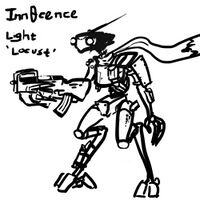
From the Locust Recon Mech to home-assist helper droids, the unifying feature is Scout shells is size. They're cute little buggers, standing between 3 and 4 feet. Their small stature makes it easy to remain unseen, and a low mass allows their long, loping legs to carry them with speed and efficiency. Scouts were often cheap and intended for high-risk tasks, and their programming prioritized getting the job done over self-preservation. In a mature sentience, this manifests as surprising courage and determination.
- Favored Attributes: Dexterity, Resolve,
- Favored Applications: Overclock, Cloaking
- Small: Scouts start with the Small Framed merit.
- Quick: Scouts start with one dot in Fleet of Foot.
- Stabilized: for the strength requirements of weapons, a Scout's strength counts as 1 higher.
- Ranger: gain a free Specialty in Stealth or Athletics.
Persona[edit]
Humans have always passed off unpleasant or tedious tasks to machines, including interacting with other humans. Persona shells come with advanced emulation software that tracks human social cues like posture, tone of voice, and facial expressions. End-users demanded customization, and Persona machines thus operate on Open-Source software and have an endless plethora of adjustable settings and add-on features. Their hardware and software favor precision over brute strength, and roughly half have vaguely feminine proportions. This shell class also covers many medical robots, especially those associated with patient care.
- Favored Attributes: Dexterity, Presence
- Favored Applications: Overclock, Technopath
- Become a Real Boy: Once per scene, a Persona robot may elect to gain the 9-again rule on a single Social skill test.
- Fluent in 6 Million forms of Communication: Persona robots know all major pre-loss languages, and any likely local dialects. The Machine must pick two languages to be Fluent in; all others are only passable.
Commando[edit]

The whole point of machines is to send something with human capabilities into situations that would be dangerous or unpleasant for actual humans. From combat zones to harsh climates, Commando robots can absorb massive abuse and still remain functional. Intended as an attatchment to human squads, they tend to be team players who deeply respect the chain of command; unless they're loose cannons who are way out of line. Give me your gun and your badge.
- Favored Attributes: Stamina, Composure
- Favored Applications: Hardening, Cloaking
- Armored: Your 1/1 automatic armor stacks with/enhances any subsequent worn armor. The Integrated Armor merit costs 1 less Experience.
Toolbox[edit]
Not all shells are easy to classify. Some are so grotesquely specialized, or equipped with oddball hardware, that they fail to fit into any of the other categories. Janitor/Mechanics, Snipers, chimney sweeps, Any machine intended for a specific task or with an unusual combination of capabilities could be represented by the Toolbox shell
- Favored Attributes: Wits, Strength, Composure
- Favored Application: Pick 1 at character creation.
- Purpose: gain the Area of Expertise merit to one skill specialty. This iteration of Area of Expertise provides a +3 bonus instead of a +2. This skill must pertain to your shell's original function or purpose.
Datastore[edit]
Even more of a computer on legs than other machines, Datastore robots are packed to bursting with parallel hardware and sensory apparati. Many were research assistants capable of analyzing data, drawing conclusions, and even going a ways towards writing the subsequent paper for peer-review. Others were command-and-control, running the equivalent of a switchboard, directing data flow in the Series of Tubes.
- Favored Attributes: Intelligence, Composure
- Favored Applications: Technopath, Analysis
- All The Terabytes: You may purchase the Encyclopedic Knowledge merit for ½ the normal price, and may purchase it for multiple skills.
- I was programmed to be an Expert in this subject: gain one free specialty in Science, Academics, Craft, Medicine, or Computers.
Brute[edit]

Like the Scout, Brutes are defined by their size. Unlike the Scout, Brutes are Hueg Liek Xbawks. Even when hunched over into an ape-like stance, they push 7 feet. Brutes have massive power requirements, and thus come with full-size microfusion reactors just to keep them moving about. For all their bulk, they are surprisingly nimble, keenly aware of their mass and inertia. Most have a deeply-ingrained "gentle giant" personality.
- Favored Attributes: Strength, Wits
- Favored Applications: Hardening, Overcharge
- Big McLargehuge: Brutes gain the Giant merit for free. If they so choose, they may pay to take the Giant merit a 2nd time, increasing their size to 7.
Manufacture[edit]
Shell classification is further split by the manufacture of the machine; the grade of its components, and the sector it was intended to function within. Each Manufacture grants a bonus Favored Application. Favored Applications that “double” decrease the cost to purchase dots by 1 experience (minimum 1).
Civilian[edit]
- Bonus Application: Overclock
- Familiarity: Civilian-grade shells do not suffer from the OldWoD curse regarding Empathy or situations that involve "reading" human behavior rather than directly influencing them.
- Open-Source: Start with one bonus Specialty in a social or mental skill.
- Three-Laws Compliant: Civilian shells are heavily conditioned to respect humans. Allowing a human to come to harm is likely to count as a Break. For sheltered machines with particularly delicate sensibilities, even disobeying a human's direct order might constitute a Break.
Military[edit]
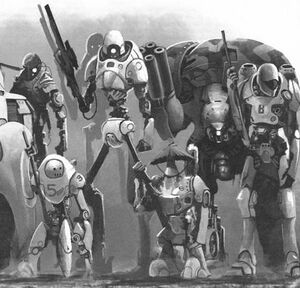
- Bonus Application: Hardening
- Impeded Mental: lose 10-again on mental skill tests.
- Grit: reduce all Wound penalties by 1
Industrial[edit]
- Bonus Application: Overcharge
- Easy Repair: repairers gain 9-again on Crafts tests to repair shell.
- Loader Industrial machines gain a +2 bonus on strength-based tests to move heavy objects
- Impeded Interaction: lose 10-again on social skill tests.
Networked[edit]
- Bonus Application: None
- Synth-Muscle: gain +1 dot to a physical attribute.
- Fringe Tech: repairers lose 10-again on rolls to remove damage or upgrade Networked shells.
- Severed: You suffer -1 to a Social attribute (this cannot reduce the attribute below 1).
- Evolved: You may purchase Plugins for one less experience (minimum 1).
Spark[edit]
What is Spark? Spark is everything within a machine that is neither hardware nor software. Spark is development along a path, a wellspring. Also, Spark doesn't really exist. Spark is the “art” in a painting that would otherwise be a collection of pigments applied to canvas. Spark is structure. As a Machine advances in Spark, it gains deeper understanding of itself; altering and tweaking its own code and shell drivers to maximize performance. Hardware and Software begin to blur, and efficiency increases beyond anything previously thought possible.
Spark functions in many ways like Blood Potency or Wyrd; it starts at 1 for free, and it may be increased at character creation by spending Merit dots at a 2-to-1 rate. Increasing Spark after this point costs new dots x6. Spark is believed to max out at 5 for normal Self-Adding Programs.
| Spark Table | |||
|---|---|---|---|
| Spark | Attribute/Skill/Application maximum | Max Charge/Charge Per Turn | Special |
| 1 | 4 | 5/1 | |
| 2 | 5 | 6/1 | |
| 3 | 5 | 7/2 | Use Willpower to increase defense/resistance |
| 4 | 5 | 8/2 | Use Willpower to augment rolls |
| 5 | 5 | 9/2 | Overcome Manufacture Limitations |
| 6 | 6 | 10/3 | Transfer Code between Quantum Drives |
| 7 | 7 | 11/4 | |
| 8 | 8 | 13/5 | |
| 9 | 9 | 15/6 | |
| 10 | 10 | 18/7 | Congratulations. You are now SHODAN. |
Charge Each shell contains a clean, reliable microfusion reactor with a constant, low power output. The reactor runs on thorium and fresh water. Thorium is easy to obtain; either recently processed or as salvage. A few ounces of Thorium allow for several months of operation; a fresh gallon of water must be cycled in every week. Excess charge from this reactor is stored in a capacitor, which the machine then uses for more energy-intensive activities. As a machine advances in Spark, it increases the operational efficiency of its shell.
Charge can be regenerated in the following ways: 2 hours hooked up to power source, such as an external generator or a solar cell in direct sunlight, restores 1 charge 2 hours in Standby restores 1 charge
At the end of a scene of strenuous activity, such as a fight or chase, a machine must make a Stamina+spark test (-1 for each previous successful test). If that test fails, they lose 1 charge.
A Machine at 0 charge is living hand-to-mouth, and suffers a -1 fatigue penalty to all actions and attributes. If another effect would cause the machine to lose charge (using another application, or engaging in strenuous activity), the Machine instead suffers a -2 fatigue penalty and keels over, inactive, at the end of the scene, and does not reactivate until it has regenerated 1 charge.
Applications[edit]
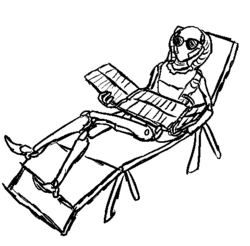
Purchasing a favored application costs new dots x 5. Purchasing any other costs new dots x 7 (a doubled-up Application costs new dots x 4). Applications are a combination of hardware and firmware; a machine with the necessary physical components must still work to utilize them to their fullest potential. The heights of most applications can only be achieved by a high-Spark machine, and were never anticipated by the original designers. Increasing dots in an application is a combination of evolving firmware, restoring long-defunct components, and adding entirely new ones.
Overclock[edit]
A machine's physical hardware does not always function to its maximum potential, to prevent accidents and undue wear. But the option to Overclock is always there. Machines skilled in the Overclock application are adept at juggling the various settings of their hardware, finding “sweet spots.”
To a machine in Overclock, the rest of the world seems to slow perceptibly. Their own shell moves slightly faster, but their reactions are faster still. Machines in Overclock can predict the paths of incoming attacks and more easily avoid them, as well as line up their own devastating strikes.
Cost: 1 charge
Dice Pool: Resolve+Wits+Overclock-previous rounds spent in Overclock during the scene.
The Machine gains the benefits of Overclock. The machine must make a test at the beginning of each round, reduced by each previous round spent in Overclock. Once the charge has been spent, the Machine may attempt any number of Overclock rolls in the scene, until it fails.
Roll Results
- Dramatic Failure: Overclock ends, the Machine loses 1 willpower, 1 charge, and suffers a -2 fatigue penalty for the rest of the scene.
- Failure: Overclock ends. The Machine suffers a -1 fatigue penalty for the rest of the scene.
- Success: The Machine gains the benefits of Overclock for the round.
- Exceptional Success: The Machines gains the benefits of Overclock for the round, and that round does not oppose/reduce the test on the following round.
Overclock Effects While in Overclock, all incoming attacks are reduced by the machine's dots in Overclock (including firearms). The Defense of all enemies targeted by the Machine's attacks is reduced as well. The Machine also adds its Overclock dots to Speed and Initiative. Overclock also improves in the following ways:
- [][]: the Machine gains the Quick Draw merit with all weapons while in Overclock.
- [][][][][]: The Machine can enter Overclock as a Reaction (see Celerity).
Action: Reflexive
Overcharge[edit]
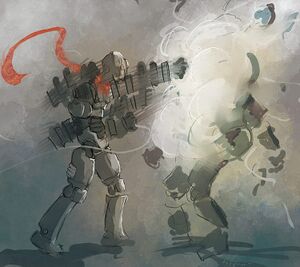
A simple application, an Overcharge-capable shell has advanced servos and cables that can handle insane current without failing. This allows the machine to tactically augment its own strength at the cost of charge.
Overcharge originally allowed machines to function as workhorses when necessary, shifting heavy loads for short times, or bend steel girders at 30 degree angles. Properly upgraded, Overcharge turns a machine into a terrifying juggernaut of destruction, tearing foes and structures apart with hideous ease.
Cost: 1 charge/scene
Dice Pool: none.
Each dot of Overchrge increases the character's Strength by one while the Application is running. Overcharge cannot be invoked more than once per scene.
Action: Instant
Hardening[edit]
Machines are tough, but some are tougher. Their shells are constructed to resist incoming trauma, and when that trauma is too great, to fail at specific break points rather than critical ones. Built of materials that alter when exposed to electrical current, a Hardened machine shrugs off wounds that would leave another bot crippled.
Cost: 1 charge/scene
Dice Pool: none
Each dot of Hardening grants the character 1 temporary point of integrity (wounds). It also downgrades one incoming lethal damage into bashing for each dot. This applies only to damage suffered while Hardening is active, not previously existing damage. When Hardening ends, the temporary integrity is lost, but any suffered damage remains.
- At [][] dots, the Machine adds its Hardening dots to resist Electromagnetic attacks.
- At [][][] dots, 1 point of suffered damage disappears when Overcharge ends.
- At [][][][][] dots, 2 points of suffered damage disappear.
Action: Instant
Technopath[edit]
Machines have an augmented ability to interact with other technology. Where humans must fumble with keys, buttons, and screens, a Machine can plug directly into a system, or access it remotely. But wi-fi hotspots are in short supply in the post-apocalypse, and most of a robot's complex networking components are useless.
Unless they get creative.
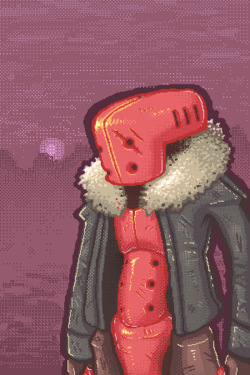
Technopathy, at its most basic level, simply represents an upscale wireless card and a bit of custom firmware. But as the machine experiments with additional transmitters and tweaked frequences, it unlocks resonances and “sweet spots” that let it pull off unanticipated feats. Eventually, the complex firmware and augmented hardware combine to hit Clarke's Third Law. The Machine can activate, power, and control simple tech over short distances, even tech that doesn't technically have wireless capability. This same principle can be used to attack other machines, assaulting their minds with intrusive signals that stun and confuse.
______[] Wifi Hotspot
- Cost: -
- Dice Pool: -
You function as a mobile wi-fi hotspot, with a range of roughly 50 meters. Within this range, you may interact with wi-fi-enabled technology, and speak silently to other machines, as well as hear their responses. However, humans find this kind of silent communication to be rude in mixed company, and many machines think its a bit silly to use face-to-face.
- Action: none
______[][] Tesla's Touch
- Cost: 1 charge
- Dice Pool: Presence+Computers+Technopath-the target's complexity
Tesla's touch has many possible uses. It allows the character to activate and manipulate technology within their immediate surroundings. Flourescent bulbs buzz, LCD screens flicker to life, stereos begin blaring random music, and so on. The technology runs off of the character's transmitted charge, and can be manipulated by the character as though they were adjacent to it. This only functions on electronics; Technopathy can't press a button, but it can make a system THINK a button has been pressed.
- Complexity
- 0: television, radio
- 1: iPod, camera
- 2: personal computer
- 3: security system, gun turret
- 4: dumb-AI robot
- 5: SAP-installed robot
The character using Tesla's touch becomes immediately aware of all active technology in the immediate area, and can then for the rest of the scene focus on specific devices, interacting with them as an Instant action.
- Dramatic Failure: complexity 0-2 technology is burned out and rendered nonfunctional
- Failure: nothing happens.
- Success: the character activates the intended tech, and can manipulate/interact with it.
- Exceptional Success: the character adds their Technopath dots to all interactions with the accessed technology for the rest of the scene.
______[][][] EM Assault
- Cost: 1 willpower, 1 charge
- Dice Pool: Intelligence+Computers+Technopath - target'sResolve+Spark
- Action: Instant
You assail your target with a burst of disorienting signals and EM radiation.
- Dramatic Failure: you cause feedback and suffer a -1 fatigue penalty for the rest of the scene. You may not use EM assault for the rest of the scene.
- Failure: No effect.
- Success: the target takes bashing damage equal to the number of successes. The target also suffers a fatigue penalty equal to your dots in Technopath until the end of your next turn.
- Exceptional Success: As above, but the target is instead stunned until the end of your next turn, rather than suffering a fatigue penalty.
______[][][][] Jam
- Cost: 1 willpower
- Dice Pool: Wits+Computers+Technopath
- Action: extended
You erect a field that hedges out all radio communication within the immediate area. This field lasts as long as you concentrate, and its strength is determined by the number of successes rolled. Breaking through the field requires a (Presence+Wits) roll that exceeds your own successes (or the applicable skill check, in the case of a human radio operator). Networked machines abruptly separated from the signal will be temporarily stunned.
______[][][][][] EMP
- Cost: 1 willpower, 2 charge
- Dice Pool: Intelligence+Computer+Technopath - vs Resolve+Spark
- Action: Instant, opposed
You unleash a dreaded Electro-magnetic pulse in a 10-meter burst. All machines within the affected area are hit by an EM assault. Unshielded Technology of complexity 3 or lower is utterly wiped with no defense allowed.
Cloaking[edit]
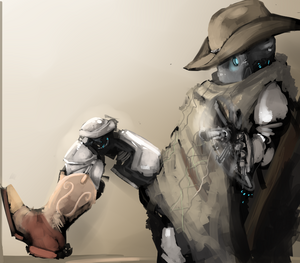
the role of Scout is a common one amongst machine combatants; being sent into hostile territory is exactly the sort of job humans DON'T want. With this in mind, many shells bear technologies that conceal a robot's presence. Some industrial or civilian shells were also intended to be unobtrusive, and have rudimentary stealth components to that end.
Cost: -
Dice Pool: Dexterity+Stealth+Cloaking
Roll Results
- Dramatic Failure: your gears bind and squeal, or your shell is covered in garish eye-catching colors. Any Stealth tests you make during the scene automatically fail.
- Failure: your Cloaking hardware fails to engage. Nothing happens.
- Success: you gain the benefits of Cloaking until the end of the scene.
- Exceptional Success: as above, except you also add your Cloaking dots to Stealth Tests for the rest of the scene.
- []: Your shell's movement is silent. This effect is always active. Opponents attempting to detect you via hearing alone test against your dots in Cloaking
- [][]: Technological means of detecting you (scanners, infra-red, and so forth) can be baffled by your Stealth skill.
- [][][]: You do not require cover to use Stealth. You may hide in plain sight. Attacking or moving ends this effect. This consumes 1 charge.
- [][][][]: As above, but you may move while Cloaked without ending the effect.
- [][][][][]: As above, but you may move and attack without ending the effect.
Action: Instant
Analysis[edit]
Knowledge is Power. Knowledge is Information+Processing. Machines are all about that. Analysis allows the user to uncover important details about the target; weaknesses, resistances and so forth.
Cost: 1 willpower
Dice Pool: (relevant skill)+wits+Analysis
The relevant skill varies based on target. For Machines, it is craft. For humans, Medicine.
Analysis can only be used on a target once/scene. For each success, you may add +1 to a test regarding/vs that target until the end of that scene. You may only add a number of dice to a single roll equal to or less than your dots in Analysis. The Storyteller may also provide snippets of applicable intel regarding the target.
- Roll With It
At [][] dots, you may spend Analysis dice to increase your defense or resistance vs the target's attacks, or when the target subjects you to an effect that allows an opposed roll. When adding to defense or resistance, roll the dice and add any successes to the relevant trait.
- Go for the eyes, Boo!
At [][][] dots, you may allocate up to 3 analysis dice to an ally as a move-equivalent action.
Action: Reflexive

Merits[edit]
Alternate Costs: Machines may purchase Ambidexterity at any time, for 2 dots instead of 3. Other Merits available at character creation only could be obtained by machine characters after this point, but only by ST permission, and possibly at increased cost.
Accessory ( [][][] )
Similar to Retainer, your character owns a lesser machine that lacks a true AI. Called Drones, Dolls, or other names based on their function, accessories have limited abilities, excelling in only one particular area, and sucking at everything else. They are heavily reliant on specialties, and are easily confused when operating outside their normal parameters. Accessories do not have Willpower, and do not generate Charge. An Accessory's maximum charge is equal to its Stamina + 1.
Building an Accessory: all attributes start at 1; 5 dots may be allocated. No attribute may exceed 3. 8 skill dots may be allocated, with maximum of 2. The Accessory gains 8 specialties (which stack up to 2), and a special ability based on its intended function. See below for sample Accessories.
Both human and machine characters may purchase Accessory. Increased dots in Accessory can improve an existing Accessory's stats (each dot grants: 2 attributes, 4 skills, 4 specialties, 1 extra ability, increase all maximums by 1) or obtain an additional machine.)
Integrated Armor ( [][] to [][][][][] )
The Machine's "natural" armor becomes the number of dots in this merit. This armor is bulletproof. at 3, the armor gains a -1 defense penalty; at 5, this penalty increases to -2. This armor cannot be removed without a major refit, and is repaired along with the machine's shell. Any Wound penalty a machine suffers also reduces this armor by the same amount.
High-Capacity Battery ( [] to [][][] )
Add your dots in this merit to tests made to maintain charge at the end of strenuous activity.
Datalink ( [] )
The Machine bears an adaptable, prehensile cable that can quickly link with technology, including other machines. This link allows the robot to enter Cyberspace without a complex splicing process, granting a +2 bonus to tests to hack or access technology in rushed circumstances (thus offsetting the associated penalties with rushed attempts).
Plugin ( [] to [][][][] )
- (See the Mirrors: Bleeding Edge PDF. Google it)
Machines may take plugins in the same manner as human characters. Machines may use Charge to activate plugins instead of Willpower, and in fact may not use Willpower to activate a plugin until they reach spark 3, and have an upper limit on how effective these Plugins can be.
Glitches[edit]
Machine AIs grow and expand based on experience. Not all these experiences are pleasant, and most machines lack the emotional maturity to properly work through traumatic events that an adult human would shake off. Machines are encouraged to select a mental or emotional flaw at character creation. Most existing flaws can also apply to machines, but the following additional disorders are particularly suited to them. Behavior Blind is prevalent among fresh-out-of-the-box machines, and Industrial models are prone to Aloof. Corrupted memory files (Amnesia) are also common. Like other flaws, players gain the bonus XP when the flaw is properly roleplayed, especially if to the character's detriment.
Fixation: you are obsessed with some hobby, behavior, or subject, such as 20th century film or Nu Metal, unrelated to your original function. You will go out of your way to acquire/experience/talk about said subject, sometimes at personal cost.
Narrow Horizons: you do your job. Concerns outside your purpose often don't interest you in the least, unless they interfere with the completion of your task.
Pinocchio Syndrome: you really want to be human, or at least be accepted by them. You might attempt social interaction with humans at every opportunity (often a bad idea), or insist on maintaining pointless human mannerisms that irritate other machines. Not being "real" gnaws at you constantly.
Terminator: Animals hate the shit out of you. Dogs bark, cats hiss and piss on you, birds mob you, and if you were to ever encounter a shark...well, just be glad they're aquatic.
Severed: you've been freed from the collective, but stray chunks of Network programming still lurk inside your psyche. You behave oddly around Network machines and installations, exhibiting involuntary fascinations and yearnings, or are provoked into reckless rage.
Catalog[edit]
Accessories[edit]
A Self-adding Program is incredibly adaptable, able to learn and improvise to perform its tasks more efficiently. It is also very expensive, and thus robots with less demanding jobs were manufactured with a traditional hard-coded AI. While remarkably advanced, drone-level AIs lack this adaptability. Accessories serve as minions for players, and also as cannon fodder for antagonists.
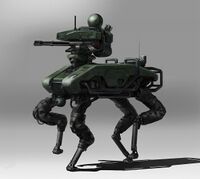


| Combat | Social | Utility |
|---|---|---|
BigDog Gun Drone
|
Replica Android
|
Assembly Unit
|
Networked Machines[edit]
Shells manufactured by Network make use of advanced technologies that were either fringe or unknown before the Loss; synth-muscle and electroconductive gel have been perfected, as have magnetic projectiles in the form of coilguns and railguns.
Instead of using Applications, Networked machines have access to integrated components that function as plugins.

Plugins often mimic the powers of other supernatural creatures; even the basic traits that grant Networked machines their claws and weapon attacks are plugins.
All Networked machines have the 12% titanium and Focused Specialist traits. They also gain the following:
LAN consciousness: Networked machines share a constant, silent link. This link extends to 100 meters If a Networked machine is advanced enough to use Willpower, all machines linked to it may spend its willpower as though it were their own. If a Networked machine is severed from this link, it must make a Resolve+Composure test or be stunned for 1 round. If it succeeds, it instead suffers a -3 fatigue penalty for 1 round. A group of Networked machines without a local commander has access to 3 willpower.
| Building Networked Machines | |||||||
|---|---|---|---|---|---|---|---|
| Rank | Attribute dots | Skill dots / Specialties | Skill Maximum | Spark | Plugin/Merit dots | ||
| Omega | 9 | 12/6 | 3 | 1 | 10 | ||
| Beta | 11 | 16/8 | 4 | 2 | 13 | ||
| Alpha | 13 | 20/10 | 4 | 3 | 17 | ||
| Alpha+ | 15 | 24/12 | 5 | 4 | 22 | ||
Seeker
|
Shredder
|
Jailer
|
Seeker: The backbone of Network's exploratory force, Seekers comb the ruins for salvagble tech. Since they're there, they also slaughter any humans lurking about the place.
Shredder: Network's basic fire support construct, Shredders favor a run-and-gun, spray-and-pray combat style that proves very effective at mowing down large numbers of unarmored targets, such as dirty human peasants.
Jailer: Network's Favored anti-machine trooper, these constructs serve as guards and taskmasters, subduing valued targets with their powerful arms, releasing electrical jolts into particularly noncompliant machines.

Marionette (omega)
|
Tormentor (beta)
|
Marionette: Network's specialized assassins, a Marionette's SAP is usually taken from a nurse or surgical assistant. Swift and merciless, they are intended to dispatch armed warriors in close quarters. In particular, they lurk in ruins that would be tempting salvage targets. Treasure hunters particularly loathe the "ninja-witches."
Tormentor: an advanced skirmisher, the Tormentor is armed with a pair of powerful "cookers" capable of blistering flesh and setting buildings alight. Used to clear settlements or harry armed columns, they rely on speed and use of terrain rather than armor.
Network Armory[edit]
Coilguns have existed in principle since the first half of the 20th century, but until materials technology became sufficiently advanced, they remained impractical as military weapons. Allellerating a magnetized projectile along a series of electroconductive coils, the weapon requres no direct contact, has minimal moving parts, and maintains a continuous rate of fire.
After breakthroughs involving room-temperature superconductors, the coilgun principle was revisited to deadly effect. Coilguns were ideal for personal defense in unstable regions. While less effective vs armored soldiers, they proved uniquely suited to combating the angry teenagers and strung-out impoverished thugs encountered on the modern battlefield.
Network heavily favors Coilguns on its combat shells for logistical reasons; without reliable supply lines, each machine must be largely-self-sufficient. To this end, Network manufactures portable micro-forges capable of rendering down scrap metal into bladed flechette rounds. Larger models have the micro-forge integrated into the weapon itself.
All coilguns are fully automatic weapons, capable of short, medium or long bursts, but incapable of single-shot fire. A short burst expends 10 rounds, a medium 20, a long burst 30.
Coilguns can run off of an integrated battery, but are more often plugged into a machine's onboard capacitor, also incorporating an external ammo feed. Each use of a coilgun in combat imposes a -1 penalty on the subsequent roll to maintain charge. Coilguns with integrated batteries can fire 10 combat rounds continuously before being expended. Flesh Shredder: armored targets hit by coilgun flechettes count their armor as double. If a target suffers 5 or more damage from a coilgun, one point of that damage becomes upgraded in severity (bashing to lethal, lethal to aggravated).
Spike Rifle: Network's favored anti-material weapon, the spike rifle uses volatile liquids to propel armor-peircing spikes in short bursts. The rounds suffer heavily from drop, as well as tremendous drag, but at short-to-medium range, it is devastating. The Spike Rifle only fires 3-round semi-auto bursts. Spike Rifles have incredible recoil, and can only be wielded by Network's larger combat machines.
Nailer: a coilgun variant, the Nailer fires heavier flechettes capable of piercing light armor. The heavy nails have large power requirements, and the weapon is only capable of firing short full-auto bursts.
Rail Rifle: a weapon of myth, the rail rifle needs little introduction. The Network variant can select between solid-shot and sub-munition ammo, and firing the weapon consumes one charge. Rail Rifles can be fitted with an onboard battery that holds 3 charge, but most are plugged directly into the wielder's chassis. When fitted to one of Network's larger constructs, a submunition shot's spread can take out multiple targets at once.
| Networked Weapons | ||||||
|---|---|---|---|---|---|---|
| Weapon | Damage | Range | Clip | Strength | Size | Special |
| Light Coilgun | 1 | 20/40/80 | 150 | 2 | 2 | Flesh Shredder |
| Heavy Coilgun | 2 | 40/80/160 | 300 | 3 | 3 | Flesh Shredder |
| Spike Rifle | 3 | 30/60/80 | 30 | 4 | 4 | AP 2, 9-again |
| Nailer | 1 | 20/40/80 | 30 | 2 | 2 | AP 1 |
| Railgun (solid shot) | 5 | 200/400/800 | 5 | 3 | 3 | AP 3 |
| Railgun (submunition) | 5 | 20/40/80 | - | - | - | AP 1, 9-again |
Cyberspace[edit]
Machines have an enhanced ability to interact with electronic systems. While they can (and usually do) work with human-level interfaces, they are capable of splicing their consciousness directly into a computer capable of handling the procedure. This includes other machines and large, stationary systems or building-wide networks. Machines without the Data Cable merit require a tedious process of opening up their case and finding the proper plugs. The subsequent activities are represented as a jaunt into Cyberspace.
Cyberspace utilizes "spirit world" mechanisms, and allows machine characters to reassemble and retrieve lost or encrypted data, break through insurmountable firewalls, or other tasks that would baffle the most tech-savvy human operator.
Machines in Cyberspace have 3 stats (taking the highest of their Mental or Social attribute) Power, Finesse, and Resistance. They have a Integrity equal to Power+Resistance, Defense and Initiative equal to their Finesse, and Speed equal to Power+Finesse. They may use a number of scripts equal to their Spark, but only one script may be used at a time. Switching active Scripts is a minor action.
Profiles[edit]
profiles differentiate Machines rather like Shells, describing the form their avatars take within Cyberspace.
Hulking: +2 to integrity
Svelte: +2 initiative
Sprinter: +1 speed, +1 to defense
Cherub: -1 to Power, Finesse, and Resistance, run an additional Script
Terror: expend 2 minor actions for 1 quick action.
Scripts[edit]
Scripts are the cyberspace representations of programs like viruses, firewalls, and so on. GMs can default to hollywood hacking tropes to come up with interesting scripts. They all functionally add to dice pools and allow the use of skills within Cyberspace
Proxy Code: grants camouflage, augmenting the use of Stealth by +2
Worm: manifests as a sword, adding +2 to melee attacks
Virus: manifests as a projectile weapon, allowing for a Finesse-based ranged attack at +1
Firewall: reduce all incoming damage by 1
Disc check: +2 on Perception tests, +1 to defense